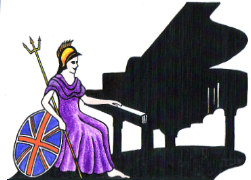Teachers, Accompanists and Piano Entertainers in the UK

UK Piano Page

Our website known as the "UK Piano Page". It contains information about everything related to pianos; we are the home of UK piano industry. We have designed the site to make things easier to find and allow professionals listed on this site to update their details. We have one of the largest collections of piano history information on the internet, with a special emphasis on the history of the piano industry in the United Kingdom. We also cover a wide selection of overseas piano makers, and provide links to sites with a piano history theme.
The UK Piano Page also contains a wealth of information on tuners, manufacturers, movers, accompanists, teachers, entertainers, hire companies, French polishers, piano part makers, and piano construction. You may even find places to wine and dine with live piano music in the background.
We have a database of pianos for sale by shops around the UK, as well as a free section for the general public to advertise their pianos for sale. We also operate an extensive online piano gift shop where you can buy piano stools, castor cups, metronomes and lots of other piano related gifs and accessories. If you would like to advertise on the UK Piano Page, please visit our advertising page.
Answers to a variety of piano-related questions are found on the pub quiz page. We have an active piano discussion forum where you can seek answers to questions on pianos, their history, and piano music.
The Association of Blind Piano Tuners exists to serve the professional and particular needs of its members and other blind and partially sighted piano tuners throughout the world.
Students
Student Membership is open to all visually impaired persons in full time training.
Friends
A Friend is anyone wishing to be associated with the ABPT or who has helped the ABPT in the past, or made a donation.
International Members (MABPT)
This is open to visually impaired tuners from around the world who have attended a recognized training school and are qualified.
Members (MABPT)
This is for visually impaired tuners from the UK who have attended a recognized training school and qualified with the AEWVH (CTB) diploma or equivalent.
Fellows (FABPT)
This is open to members of the ABPT who have undergone extra training to enhance their skills.
Honorary Life Members
This is open to members of the ABPT who have been members for over ten years and have satisfied Council of their eminence in the profession or of the importance and value of their services to the ABPT. The status of Honorary Life Member is at the discretion of the ABPT Council, and no more than five may be serving at any one time.
Only Members and Fellows who are resident in the UK are covered by our insurance policies. Only Full Members, Fellows, International Members and Associated Members may add the letters to their name and use the ABPT logo. All membership is at the discretion and approval of the ABPT Council.
We encourage all tuners to gain and maintain the highest professional standards and to exhibit ethical and professional integrity at all times.
We offer ongoing training to piano tuners who wish to acquire extra levels of ability. This is open to all everyone, even if they are not yet members of the Association. We do this by running subsidised seminars for fully sighted and visually impaired tuners. We maintain close links with all of the professional bodies of the music industry, and in particular with piano tuning organisations worldwide. The purpose of the website is to educate the general public in the good practice of maintaining their musical instruments and using professional tuners to do this work. This follows the broad outline of our mission statement. If we may be of any further assistance to you, please contact us.
To continue as the leading authority and association for blind or partially sighted piano tuners, insisting that only those professionally trained, examined, and qualified are accepted into membership, ensuring that the public knows that an ABPT member will offer skilled, professional, and reliable service.
Unit 15, Witham Point
Wavell Drive
Lincoln, Lincolnshire LN3 4PL
England
We are dedicated piano specialists in Lincoln and
The Temple, Eastgate
Sleaford, Lincolnshire NG34 7DR
England
White & Sentance are one of the longest
24 Coronet Stree
Haggerston
Bridport Place, London N16HD
England
Thornhill Pianos is a family business selling and
39 Finch Road
Douglas, Isle of Man IM12PW
England
Peter Norris Music has now been trading for 20
126 Meadfield Rd
Langley
Langley, Berkshire SL3 7JF
England
Used and new acoustic and digital piano
Music Festival for performers and guests Our 10th
18-06-2022 12:30PM
The Morecambe Bay Piano Group was set up to extend
11-12-2021 01:00PM
The Morecambe Bay Piano Group was set up to extend
08-01-2022 01:00PM
The Morecambe Bay Piano Group was set up to extend
12-02-2022 01:00PM
New and used upright and grand pianos for sale in
Shops.